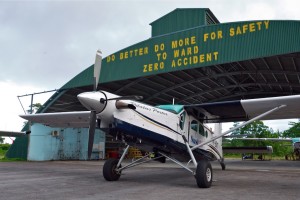 |
| Parked up outside our maintenance hanger |
The route tends to change a little depending on where we can get a load to from Timika, the farther north the better. This time around I flew a load of government subsidised rice into Doufu which very much en-route and handy 85nm north of Timika. As the aircraft needed to be in Biak before 9am that morning, I departed nice and early at 6am.
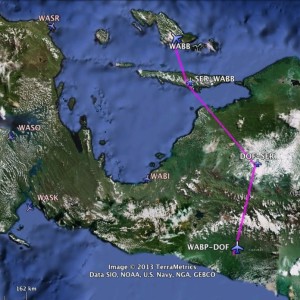 |
| Timika – Doufu – Serui – Biak |
The only trouble with Doufu is that it’s located in the northern flatlands which are low lying and fairly flooded. As a result it’s a place that is better to go to later in the day because every morning it’s usually covered by a very low layer of fog. That morning was no exception. Luckily there were a few holes dotted about the place close enough to the airstrip and big enough to slip a Porter through and land without issue.
Every time I come to Doufu the local villagers always ask if I’m going to Nabire (WABI on the map above). And every time I have to tell them no, I’m heading back to Timika. However, today I was planning on heading to Serui, an island to the north en-route to Biak. Amazingly there was big excitement amongst the villagers who all saw their chance to get a step closer to Nabire. From Serui they could either hop on a boat or aircraft to Biak and from there take another boat or aircraft to Nabire. Certainly a long trip but I guess if you’ve been waiting weeks to get somewhere and an opportunity arises, you have to take it!
 |
| Fog rolling in over the end of Doufu airstrip |
Getting out of Doufu was simply a matter of timing my departure just right for another gap in the fog which was continually wafting across the airstrip. Once through 1000ft we were back in the sunshine and heading for Serui.
I’d been to Serui about three years ago when I was flying the Caravan. Due to the nature of the airstrip (fairly short and located in a bowl with high terrain beyond the approach) it’s always known to be reasonably challenging for Caravan operations, especially once the wind started to pick up later in the day. My arrival was pretty early at around 8am, so no such issues there.
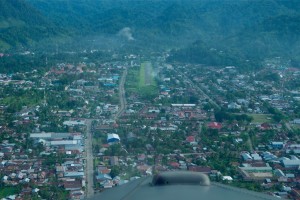 |
| Approach into Serui airstrip, Papua |
Doufu passengers offloaded, I collected seven more from Serui who wanted to get to Biak to catch the morning Garuda flight back to Jakarta, so a speedy turnaround was done and I was back in the air again.
Biak’s 3570m of runway presented no problems for the Porter and the passengers were quickly offloaded and the aircraft taxied across the runway, arriving a couple of minutes before 9am into the awaiting hands of our engineers. For me, it was to be a couple of days off to relax and enjoy the island’s legendary sunsets.
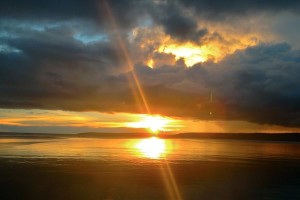 |
| Sunset over the seas surrounding Biak, Papua |
Discover more from Matt Dearden
Subscribe to get the latest posts to your email.
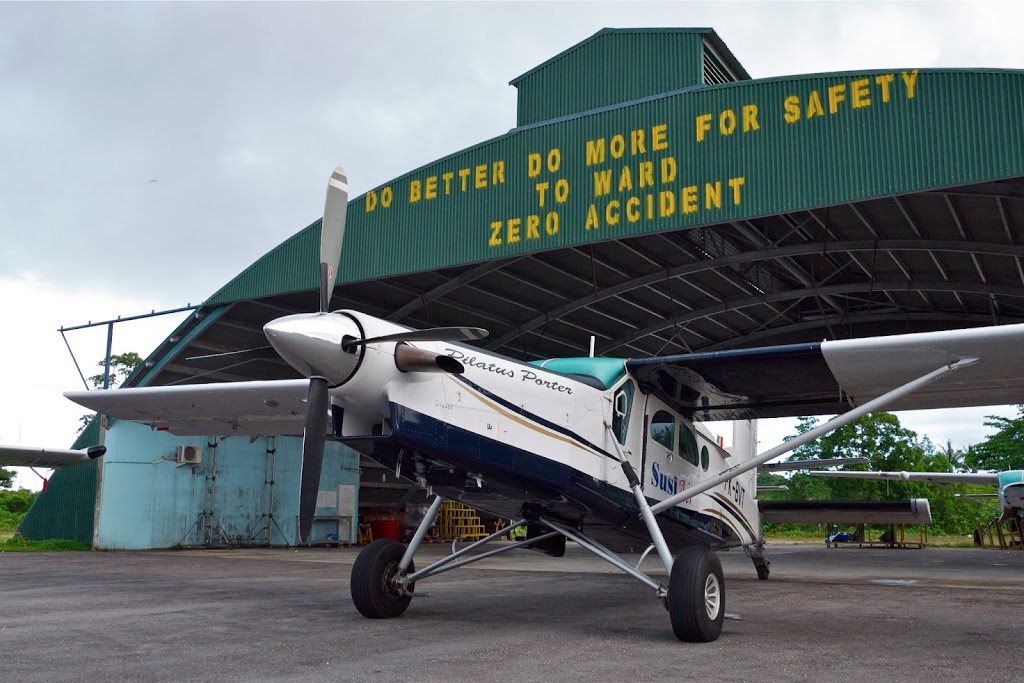
Nice flying trip matt
I always enjoy something a little different. It’s about a long a trip as I do these days thankfully. Long ferry flights in the Porter aren’t much fun with it’s lack of autopilot and rock hard seat!
Great post Matt!! – again.
In free time, could you write something about your preparing for long fly?
Thanks a lot
Luke
Hi Luke,
As and when I have to do a long ferry, I’ll write a more detailed post up about it. Basically it’s just the same as doing a PPL Nav Ex flight. You get a chart out, work out a decent route, consider diversion airfields and en route refuel airfields. Check the wx the day before and go do it!
hi
the people that hop on enroute do they get a free ride or discount? I assume they havent booked in advance
Any pax we pick up on a dead leg who just show up at the airstrip for a flight are charged the going rate which is $10 per 0.1hrs flight time. In this case that worked out at $80 per person. How and where they get that sort of cash from in the middle of the jungle, I’ve not figured out yet!
Hello Matt,
Firstly I thought I’d just say what a great blog this is. Thoroughly enjoying it!
I had a quick question and I thought there’s a chance you might be able to give me some advice.
My dream job is to become a Bush Pilot somewhere in Asia or Africa, flying Pilatus or Caravans around. In fact pretty much what you are currently doing 🙂
I’m in the process of doing my CPL in England. Once complete I’m intending to do the Single Engine IR.
I just wondered if you think it’s worth me doing the Multi Engine CPL / IR ( at a lot of extra cost ), if Bush flying is ultimately what I’m aiming for? Do you ever actually use the Multi yourself out there, or even manage to stay current for that matter, if you already have it?
Anyway, apologies for the boring question and please do keep up the blog! It’s great 🙂
Tim
Hi Tim, I’ve not flown a multi-engined aircraft for nearly four years now and don’t have any current ratings. I’ll probably renew them before they fully expire though as you never know what the future might hold.
Ultimately, for most bush flying jobs you’re flying VFR in a single engine aircraft but it’s nice to know I have the fall back of that ME/IR should my circumstances suddenly change in the future.
Hi Matt,
Thanks a lot for the response & the info.
My CPL & money haemorrhaging all start next week 😉 With this Bush Flying in mind, I think I will stick with the SE/IR route for now.
Good luck with all the flying out there!
Tim